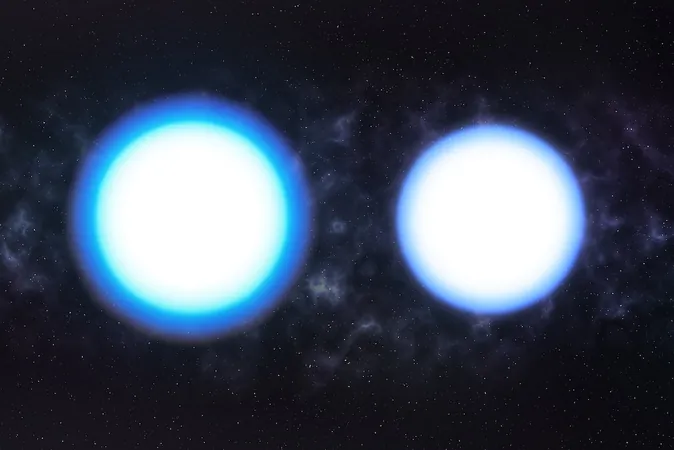
Discover How Hotter White Dwarfs Are Defying Density Expectations!
2024-12-31
Author: Nur
Groundbreaking Study Reveals Surprising Findings About White Dwarfs
In a groundbreaking study, astronomers have unveiled that hotter white dwarfs are puffier than their cooler counterparts, a finding that has profound implications for our understanding of these enigmatic stellar remnants. As our Sun nears its inevitable demise, it will eventually transform into a white dwarf, marking the end of its life cycle. A recent survey involving a staggering 26,000 white dwarfs has provided compelling evidence for a long-held theorized relationship between a white dwarf’s temperature and its density.
Understanding the Nature of White Dwarfs
White dwarfs are born when massive stars exhaust their nuclear fuel, shedding their outer layers and leaving behind an incredibly dense core. Despite their small size, these stellar remnants, which can reach temperatures between 5,000 and 10,000 Kelvin, become fascinating to astronomers for their perplexing characteristics. The study, led by Nicole Crumpler from Johns Hopkins University and published in the Astrophysical Journal, offers insights into the thermodynamics of these stars, revealing that as their core temperature increases, their outer layers become less dense and puffier.
The Relationship Between Temperature and Density
The relationship between a white dwarf's temperature and its physical structure has crucial ramifications for how we probe the universe. The research suggests that higher core temperatures create an outward push of energy, leading to the expansion of their outer layers. This phenomenon helps astronomers infer the density of these stars, which is astounding—just a teaspoon of white dwarf material can weigh nearly a ton!
Implications for Understanding Dark Matter
Crumpler highlighted an exciting application of this research: understanding the mysteries of dark matter. "If you want to look for dark matter, quantum gravity, or other exotic phenomena, it’s vital to first grasp the fundamentals of normal physics,” she noted. The puffiness of hot white dwarfs may hold the key to unlocking secrets about the composition of the universe and the nature of dark matter.
New Techniques in Stellar Research
Further investigations involved measuring the effects of high densities on light waves emitted from these stars. The phenomenon of light wave energy loss, known as ‘red-shifting,’ allows astronomers to discern the gravitational influences affecting the light, thus enabling them to calculate the temperatures and densities of these stellar bodies. Utilizing data from the Sloan Digital Sky Survey and the European Space Agency’s Gaia mission, researchers hope to create a more nuanced understanding of not just white dwarfs, but the dark, mysterious components of our universe.
Looking Ahead: The Future of Cosmic Research
As this research unfolds, the implications stretch far beyond our solar system—potentially reshaping our understanding of cosmology, astrophysics, and the very fabric of space and time. Keep your telescopes ready; the secrets of the universe are beginning to unravel in the most unexpected ways!

 Brasil (PT)
Brasil (PT)
 Canada (EN)
Canada (EN)
 Chile (ES)
Chile (ES)
 Česko (CS)
Česko (CS)
 대한민국 (KO)
대한민국 (KO)
 España (ES)
España (ES)
 France (FR)
France (FR)
 Hong Kong (EN)
Hong Kong (EN)
 Italia (IT)
Italia (IT)
 日本 (JA)
日本 (JA)
 Magyarország (HU)
Magyarország (HU)
 Norge (NO)
Norge (NO)
 Polska (PL)
Polska (PL)
 Schweiz (DE)
Schweiz (DE)
 Singapore (EN)
Singapore (EN)
 Sverige (SV)
Sverige (SV)
 Suomi (FI)
Suomi (FI)
 Türkiye (TR)
Türkiye (TR)
 الإمارات العربية المتحدة (AR)
الإمارات العربية المتحدة (AR)